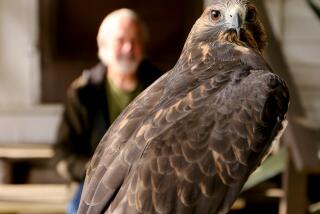Their study aids come with claws
- Share via
JOURNALIST Amy Sutherland spent a year following a group of Southern California college students immersed in their education. But theirs is no ordinary school, as her book’s title suggests: “Kicked, Bitten, and Scratched.” Graduates of the Exotic Animal Training and Management Program at Moorpark College go on to work for the world’s animal sanctuaries, circuses, zoos and aquariums, and some even train animals for Hollywood.
Sutherland, who grew up with a menagerie in suburban Cincinnati, has always found animals “an endlessly compelling and integral part of the world.” Indeed, she writes, “[a] life without this passion has always struck me as a lesser one, and I admit to being a hard judge of people who do not share my love for the animal kingdom. At worst, I consider them suspicious; at best, deeply flawed.”
Years ago, while on assignment for Disney magazine, Sutherland spent time on the Paris set of “102 Dalmatians,” where she talked shop with animal trainers and learned of the animal training program. “That such a place, a college that taught people to train everything from rabbits to tigers, existed struck me as incredible.”
Despite its carnivorous-sounding acronym, EATM offers a training environment in which animals are respected and given affectionate care -- aside from the need to feed many of the zoo’s creatures fresh prey (such as rats and pigeons). Founded in 1974 with a wolf named Kiska, the two-year Ventura County program has grown to include nearly 200 animals. While researching her book, Sutherland got kisses from a sea lion, played with a baby orangutan and watched students teach a camel to play basketball and a hyena to spin.
Some people object to any training for wild animals, its apparent master-slave dynamic and the stress it often places on animals. Others argue that animals enjoy learning and engaging with humans. Arguably, if they would be in captivity anyway, depression and boredom can be alleviated through training, which at least offers exercise and mental stimulation.
Sutherland contends that EATM produces graduates who largely improve the lives of captive creatures. “[T]raining is no longer thought of as a means to dominate an animal but rather as a means to communicate,” she writes, adding that the bond between many animals and their trainers is truly amazing.
“Trick” is “a word that conjures up the politically incorrect big top and the darker aspects of animal training,” Sutherland writes. Today, animals are taught “behaviors,” and they are kept in “enclosures,” not cages. “Times have changed and this linguistic shift reflects that.” Trainers also study species’ natural behaviors “so they know what will come easily to an animal and what won’t.... For example, baboons jump in the wild as a way to make themselves look bigger. In the open ocean, wild dolphins arc high out of the water just as they are trained to do in shows. Trainers learn an animal’s physiology so they know what it can and can’t do.”
The program’s rigorous curriculum isn’t for those drawn to the cute and cuddly. “This is the Harvard for exotic animal trainers,” Sutherland writes. The mostly female students endure boot-camp days that begin at 6:30 a.m. with cleaning dens, feeding animals and attending classes on wildlife education, animal behavior and anatomy. They also must be mindful of the risks, of being kicked, bitten, scratched, maimed or killed -- even the best-trained animals are unpredictable, she reminds.
EATM students aren’t looking to become vets; they are training for a specialized job, one that pays terribly, at least to start (often in the $8-an-hour range).
Sutherland follows them from first-day jitters to graduation, concluding that after walking a cougar, holding a boa constrictor and teaching a kinkajou to go into a crate on command, anything seems possible.
“Kicked, Bitten, and Scratched” provides plenty of satisfying “awww!” moments with baby animals. It also chronicles difficult and upsetting experiences. Decide for yourself the ethics of exotic animal training, but this is a book written by an unabashedly passionate animal lover -- and anyone who reads it will never view animals in quite the same way again.
Carmela Ciuraru is the editor of six anthologies of poetry, including “Solitude” and “Motherhood.”
More to Read
Sign up for our Book Club newsletter
Get the latest news, events and more from the Los Angeles Times Book Club, and help us get L.A. reading and talking.
You may occasionally receive promotional content from the Los Angeles Times.










